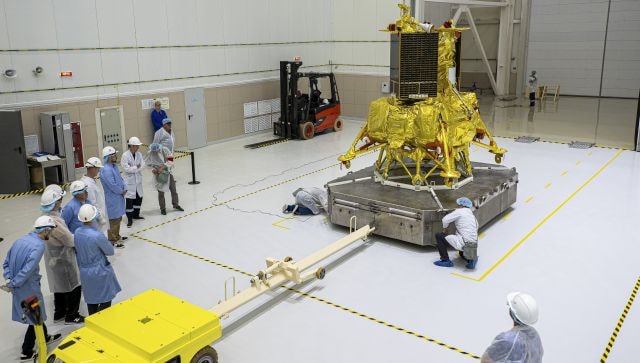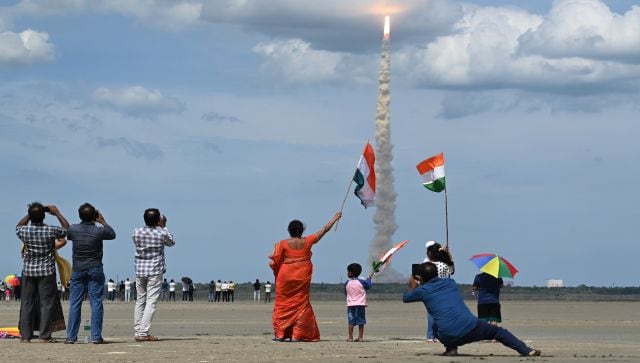India is keeping its fingers crossed and its eyes trained on the ambitious Chandrayaan-3. The spacecraft heading toward the Moon is all set to touchdown on 23 August, Wednesday, around 6.04 pm IST. This is India’s third attempt at a lunar mission and while Chandrayaan-3 is bigger and better than its predecessor, Chandrayaan-2, it is surprisingly cheaper.
We take a look at the money involved and how the Indian Space Research Organisation (ISRO) manages to keep the costs of its projects low.
What is the cost of Chandrayaan-3?
After the Chandrayaan-2 mission failed, India announced Chandrayaan-3. It was expected to be launched in 2021 but the COVID-19 pandemic led to delays and the spacecraft took flight on 14 July.
Now as it hurtles closer to the Moon, history is in the making. If successful, India will become the first country to land on the treacherous and unexplored south pole of the satellite. Yet, it is not shelling out hundreds of billions like other nations have on lunar explorations.
One of the many interesting aspects of Chandrayaan-3 is its cost. An estimated Rs 615 crore has been spent on the project and it is said to be one of the country’s most cost-effective space missions.
…. and
The moon as captured by the
Lander Imager Camera 4
on August 20, 2023.#Chandrayaan_3 #Ch3 pic.twitter.com/yPejjLdOSS— ISRO (@isro) August 22, 2023
In December 2019, ISRO reportedly requested the initial funding of the project – Rs 75 crore out of which Rs 60 crore would be utilised for meeting expenses of machinery, equipment and other capital expenditure. The remaining Rs 15 crore was sought under the revenue expenditure head, reports CNBC TV18.
In 2020, former ISRO chief K Sivan said that the cost of Chandrayaan-3 was around Rs 615 crore. The lander, rover and propulsion module cost Rs 250 crore and the launch services cost around Rs 365 crore.
There is a possibility that the mission’s budget has increased considering it was supposed to be launched in 2021 and has been delayed by two years. But unlike budgets for roads and infrastructure which escalate massively over time, the cost of India’s moon mission is likely to have remained under control. To put things in perspective, the Dwarka Expressway, India’s first eight-lane elevated highway connecting Delhi and Haryana, is built for Rs 9000 crore.
Also read: How is ISRO’s Chandrayaan-3 mission different from Chandrayaan-2?
In fact, Bollywood and Hollywood movies have budgets far bigger than Chandrayaan-3. Tom Cruise’s latest Mission: Impossible – Dead Recoking Part One had a staggering budget of Rs 2,386 crore ($ 290 million) and the Prabhas and Kriti Sanon-starrer Adipurush is budgeted at Rs 700 crore.
Interestingly, Chandrayaan-2 cost more than Chandrayaan-3. The first cost India Rs 978 crore, which included Rs 603 crore for the orbiter, lander, rover, navigation and ground support network. The Geo-stationary Satellite Launch Vehicle cost Rs 375 crore.

How much do other countries spend on space missions?
Chandrayaan-3 was up against Russia’s Luna-25 in the race for the Moon’s south pole. However, the Russian mission failed as crashed into the lunar surface.
Luna-25 was Russia’s first mission to the moon in 47 years and the country reportedly spent an estimated $200 million (Rs 1,659 core) on it. This is said to have included the expense of building the spacecraft, developing launch operations, mission control and more.
The total cost of China’s Chang’e-4 lunar mission, which touched down on the moon in January 2019, was “not too much”, according to Wu Yanhua, deputy director of the project. “The cost is close to building one kilometre of subway,” he said in a press conference back then. The cost per kilometre of a subway in China varies from 500 million yuan (Rs 568 crore) to 1.2 billion yuan (Rs 1,365 crore), reports CGNT.

The cost of NASA’s new moon rocket Space Launch System (SLS), which intends to return humans to the moon, has been going up significantly. Four contracts for the rocket's booster and engine were initially projected to cost $7 billion (Rs 58,185 crore) over 14 years but are now projected to cost at least $13.1 billion (Rs 1.08 lakh crore) over nearly 25 years, according to Space.com.
The complex Artemis, which requires building a facility similar to the International Space Station in the moon’s orbit, is estimated to cost $100 billion (Rs 8.3 lakh crore) by 2025.
Even India’s other space missions have been cheaper than Western standards. NASA’s MAVEN Mars mission had an estimated cost of $671 million (Rs 5,566 crore) while the European Space Agency Mars Express had a budget of around $164 million (Rs 1,349 crore). India’s Mangalyaan, an operational mission to the red planet, was developed at Rs 450 crore ($74 million).
How has India kept costs low?
Leave alone other space missions, ISRO’s projects are often compared with Hollywood space films like Interstellar and Gravity. In 2014, Prime Minister Narendra Modi was in full praise of the country’s cost-effective space programme, saying the Mars mission cost less than Gravity, which was made at an estimated cost of $100 million.
Even today, at Rs 1,062 crore ($165 million), the 2014 sci-fi blockbuster Interstellar costs more than twice as much as Chandrayaan-3’s entire budget.
Former ISRO chairman Dr K Sivan told The Times of India (TOI) in 2018, “We keep strict vigil on every stage of spacecraft’s development, therefore, we are able to avoid wastage of products.”
India has used the PSLV for multiple missions to keep launch budgets in check. In a 2014 speech, PM Modi mentioned how rocket cones are transported on bicycles, as he praised the “power of imagination” of Indian scientists.

India has over the years prioritised homegrown components and technologies over costly imports. “ISRO pursues the indigenisation programme for critical components and materials with industry participation to reduce the dependence on import. The Indian industry is contributing significantly in the designing, manufacturing and testing of components and material as well as sub-systems as per ISRO's requirements,” a scientist working with the space organisation told Outlook.
Another big aspect of keeping costs low is India’s ability to adapt existing space technologies. There is no dearth of skilled engineers and scientists in the country who earn far less than their Western counterparts.
India also likes to keep things simple. The payload of Mangalyaan was about 15 kg compared to that of the Maven, which explains the difference in costs. India’s Chandrayaan-3 is less powerful than America’s Saturn V. It is slower than Russia’s Luna-25. But today, there are more chances of India making history.
Over the years, the country’s space programme has gathered momentum. It has come a long way since it first sent a probe to orbit the Moon in 2008. India might be slow but it is definitely steady and it is here to win the race.
With inputs agencies
from Firstpost India Latest News https://ift.tt/39BHho8

Comments
Post a Comment